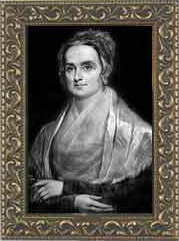Lucretia Mott
Let our lives be in accordance with our convictions of right, each striving to carry out our principles
Lucretia Mott

From a sermon delivered at the Cherry Street Meeting in Philadelphia, September 30, 1849. In Lucretia Mott Speaking. Edited by Margaret Hope Bacon1
Political and social reformer Lucretia Coffin Mott was born on January 3, 1793 in Nantucket, Massachusetts. Inspired by a father who encouraged his daughters to be useful and by a mother who was active in business affairs, Lucretia Mott agitated for the oppressed while raising six children. Over the course of her lifetime, Mott actively participated in many of the reform movements of the day including abolition, temperance, and pacifism. Most importantly, however, she inaugurated the woman suffrage movement.
Mott’s commitment to women’s equality was strengthened by her experience as a student and teacher in Poughkeepsie, New York. While at a Quaker boarding school there, she was struck by the fact that “the charge for the education of girls was the same as that for boys, and that when they became teachers, women received but half as much as men for their services…The injustice of this was so apparent,” Mott recalled in an autobiographical sketch, “that I early resolved to claim for my sex all that an impartial Creator had bestowed.”
After marrying fellow teacher James Mott in 1811, she resided in Philadelphia. Both Mott and her husband were ardent abolitionists and members of the Society of Friends. After passage of the Fugitive Slave Law of 1850, the Mott home became a station on the underground railroad. Mott’s insight and abilities as a speaker resulted in her 1821 recognition as a minister. By the 1830s, Mott traveled widely lecturing against war, intemperance, and slavery.
Mott met Elizabeth Cady Stanton at an 1840 meeting of the World Anti-Slavery Conference in London. Though delegates to the convention, Mott and Stanton were denied the right to participate because of their gender. They agreed that the status of women must be advanced.
In 1848, Mott and Stanton launched the woman’s rights movement in the United States by calling the Seneca Falls Convention. The Declaration of Sentiments signed by Stanton, Mott, and other participants called for the extension of basic civil rights to women. These included the right to vote and the right to hold property.
On the centennial of American independence, Mott and the National Woman Suffrage Association renewed their call for women’s equality in their 1876 Declaration and Protest of the Women of the United States. The document called for impeachment of United States leaders on the grounds that they taxed women without representation and denied women trial by a jury of peers.
Though women did not receive the right to vote for another forty years after Mott’s 1880 death, she lived to see fulfillment of several demands set forth in the Declaration of Sentiments. By 1880, for example, most states granted a woman the right to hold property independent of her husband, and several state and private colleges admitted women.
Learn more about the life and times of Lucretia Mott and other American foremothers:
- Visit Votes for Women, 1848-1921. This collection includes the minutes of twenty-two Woman’s Rights conventions, many from Mott’s most active years in the movement. Search on convention to explore this archive. The timeline One Hundred Years Toward Suffrage provides an overview of the movement.
- Browse the subject index of “Votes for Women” Suffrage Pictures, 1850-1920 to locate portraits of movement leaders, as well as photographs pertaining to the history of the cause.
- Like Mott, Elizabeth Cady Stanton was concerned about women’s positions within social institutions. Stanton’s The Woman’s Bible set forth her views on religion and the church’s role in limiting women’s progress. A draft of this work is featured in Words and Deeds in American History.
- Examine the Declaration of the Anti-Slavery Convention assembled in Philadelphia on December 4, 1833 which is in the collection An American Time Capsule: Three Centuries of Broadsides and Other Printed Ephemera. James Mott is included in the list of signatories at the bottom of the document.
I have no idea of submitting tamely to injustice inflicted either on me or on the slave. I will oppose it with all the moral powers with which i am endowed. I am no advocate of passivity.
Lucretia Mott
Sources: Margaret Hope Bacon, editor, Lucretia Mott Speaking : Excerpts from the Sermons & Speeches of a Famous Nineteenth Century Quaker Minister & Reformer (Wallingford, Pa.: Pendle Hill Publications, 1980).